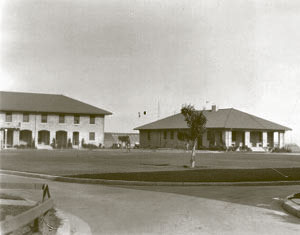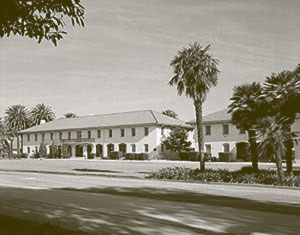The History of Fort MacArthur
Guardian of Angels Gate
|
|

Enlisted Barracks and Guard House
taken in 1923 by then Maj. George Ruhlen |
On September 4, 1888 by
Executive Order, the “Old Government Reservation” next to
San Pedro Bay became property of the U.S. War Department.
The property was originally a Spanish public landing and was
reserved as “Government Land” when the United States gained
control of Alta, California in 1848. In 1897 and 1910
additional tracts of land were added to the reservation in
preparation for the construction of fortifications to guard
the newly completed deep water harbor facilities of the port
for the city of Los Angeles. The reservation was
geographically divided into three parts: the Lower
Reservation, Middle Reservation, and Upper Reservation.
In 1914 the property was named Fort MacArthur in honor of
Lt. General Arthur MacArthur, Civil War Medal of Honor
recipient and father of General Douglas MacArthur.
|
By 1919,
construction had been completed on Fort MacArthur’s main
armament of four 14-inch rifles mounted on ingenious
“disappearing carriages” and eight 12-inch mortars mounted
in massive concrete emplacements. These guns protected Los
Angeles Harbor and had a range of up to fourteen miles. In
addition to the big guns, electrically controlled mines were
stored on the Lower Reservation for rapid deployment across
the harbor entrance and were protected from enemy mine
sweepers by four 3-inch rapid fire guns located on a sand
spit off the end of what is today known as Terminal Island.
By this time, the barracks and administration buildings on
the Middle and Upper Reservations were also nearing
completion.
After World War I, Fort MacArthur was regularly used for
training and housing of California National Guard units,
Citizens Military Training Corps, Army Reserve units, and
the Civilian Conservation Corps. In 1920, four 3-inch
anti-aircraft guns were added to the post’s arsenal and two
155mm guns were delivered in 1928. The biggest additions of
firepower came to Fort MacArthur in 1925 and 1930 in the
form of two 14-inch railway guns. Named Battery Irwin, these
mobile guns could fire their 1400 lb. shells a distance of
27 miles and were eventually stored in special “breakaway”
buildings.
After the attack on Pearl Harbor on December 7, 1941,
additional 155mm and 3-inch anti-aircraft guns were added to
the defenses of Los Angeles and a new fortification program
hurried toward completion. This included the addition of
Battery Paul D. Bunker located at White Point, and another
unnamed 16-inch battery at Bolsa Chica beach that was never
completed. These batteries were armed with two 16-inch
barbette mount guns enclosed under large concrete portals.
These were the largest and most powerful seacoast defense
guns ever deployed by the United States and had a maximum
range of about 26 miles.
To reinforce these batteries, three new 6-inch batteries
were also built. Battery Harry J. Harrison at Bolsa Chica,
Battery Barnes at Long Point, and Battery 241 located on the
Upper Reservation. These guns were protected by 6-inch thick
“teardrop” shaped metal shields, and looked like they would
be more at home on a warship rather than on a hilltop
overlooking the Pacific Ocean. Additionally, more than a
dozen 90mm and 37mm guns were installed around the harbor
area. As these new weapons were installed, the older guns
were deactivated and shortly after 1945, all of Fort
MacArthur’s big guns were cutup for scrap. Fort MacArthur
continued to serve as an induction and separation center
throughout the 1940s and 1950s
|
From
1950-1974, Fort MacArthur was part of the Nike
surface-to-air defense system. At its peak in 1958, over
eighteen missile launch sites were administered through Fort
MacArthur at areas surrounding Los Angeles -- from the San
Gabriel Mountains to the north and the Whittier Hills to the
east. In 1954 a Nike Ajax missile launching complex was
installed at White Point, and Batteries Leary - Merriam were
converted as its radar control station. The launch facility
was later upgraded to support the nuclear-armed Nike
Hercules System. In the 1970s the Nike missile system was
declared obsolete and all of the sites were deactivated.
In 1977, the Army decided that Fort MacArthur no longer fit
its needs and declared it surplus property.
|

Fort MacArthur Enlisted Barracks
on the Middle Reservation taken in 2002 |
At that
time, the Upper and Lower Reservations were deeded to the
city of Los Angeles and within a few years all of the
buildings on the Lower Reservation were removed and the
property was dredged to create the Cabrillo Marina. The city
of Los Angeles turned the Upper Reservation into a city park
in 1982.
Fort MacArthur’s 94 years as an Army installation came to an
end in 1982 when the Middle Reservation was transferred to
the Air Force for use as a housing and administration
facility supporting the Los Angeles Air Force Base. Today
Fort MacArthur continues to serve the United States in that
capacity. |
|
 |
|
The Guns of Fort MacArthur |
 |
|
|
|